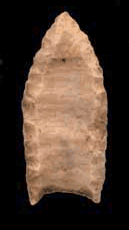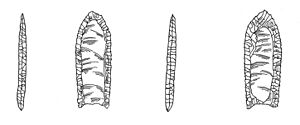Folsom point facts for kids
Folsom points are special stone tools. They are a type of projectile point, like an arrowhead or spear tip. These points were used by ancient people in North America. They are part of what archaeologists call the Folsom tradition.
The name "Folsom point" comes from the Folsom site in Folsom, New Mexico. This is where the first one was found. In 1908, a cowboy named George McJunkin discovered it. It was found with the bones of a bison, an animal the Folsom people hunted. Scientists recognized it as a unique tool in 1926.
What Do Folsom Points Look Like?
Folsom points are made from stone. They are shaped on both sides, which is called bifacially worked. They have a balanced, leaf-like shape. The bottom part, called the base, curves inward.
A special feature is a wide, shallow groove. This groove runs almost the whole length of the point. This groove is known as fluting. The edges of the point are very carefully shaped.
Scientists think the fluting helped attach the point to a wooden spear or dart. This process is called hafting. Studies show some Folsom points were also used as knives. Making the fluting needed great skill. It took archaeologists many years to learn how to copy it. This type of fluting is seen as a very advanced stone tool technique.
When Were Folsom Points Used?
Folsom points are found across North America. They were used between about 9500 BCE and 8000 BCE. Finding these tools in the early 1900s was very important. It helped scientists understand when the first humans arrived in North America. Before this, many thought people had only been there for about 3,000 years. Folsom points showed that people had been there much longer.
In 1932, an even older type of point was found. These were Clovis points. Clovis points date back to about 11,500 BCE. They have been found right next to mammoth skeletons. This shows that ancient people hunted mammoths.
In the Great Plains area, people later started using different points. These were called Plano points. They were made by various Plano cultures.



